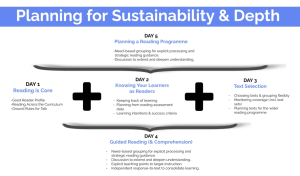Today was all about planning a reading programme and I felt like even though I’ve been out of the classroom for a while, there was a lot covered today that linked back into things that were a regular part of my practice when I was back in the classroom. Sometimes it feels like it’s been a looooong time since I had my own class and therefore feel quite rusty around some things. But to recognise so many of these elements and to know that knowledge hasn’t left the old brain what quite nice!
I’ve taken this screenshot here which captures the main elements of today. Love’d those “rules of thumb” around timetabling. It was always such a juggle to fit in all the elements we wanted to cover – and I feel like this is where things like the digital affordances really come into play – as Georgie said, if the programme is clearly laid out and the students know the expectations, then it can save you 10-15mins for each learning area – adding up to 30-45mins per day, where you can just say to the students “It’s reading time, go find what you need on the site and get going” rather than needing to go through what each group was doing, where they could find the things they needed etc etc. Of course this takes practice and can’t be leapt into on day 1 of term 1, but it’s about building those routines, just like all the other routines we build in our classrooms.

Looking further into the reading apps we touched on today, highlighted just how powerful these are – like so many teachers, I only really scraped the surface of these when I was using them in my classroom. It was great to have Naomi and Toni share their in depth knowledge of these, and then to think about the different purposes for these different apps.

I really enjoyed the activity we did where we were reading like Writers -taking the sample that Naomi shared and the way we were scaffolded to write our own passage through the use of a writing frame – such a great task and so powerful.
I feel very grateful to be able to take part in the Reading Practice Intensive. To see how the elements are interwoven and entwined to create such an rich full reading programme in a classroom is such a fabulous learning opportunity for myself, as well as for the teachers who are taking part. I really do wish something like this had existed when I was teaching in the classroom. Will there be any analysis of the reading data for the teachers who have taken part in the RPI this year? I think that would be really interesting to look into once the end of year data is gathered.


Kia ora Vicki
I totally agree that you must often feel that sense of déjà vu as we cover well worn ground from when you were in the classroom, particularly those elements that you recognise as timeless, effective practice! Similarly, as you say, it’s those systematic, core routines (amplified by digital tools) that offer extra affordances including efficiencies of time and learner self-management. When you rightly talk about this as a ‘building process’, it re-emphasises for me ways we can recycle back in the RPI to keep ‘nudging’ our participants to strengthen routines and refine these affordances.
Like you, many participants blogged about the key takeaways from the session on reading apps and again how to make optimised use of select features. As you point out, it’s about learning design and knowling how you can work ‘smarter not harder’ to achieve quality shifts across your programme design by leveraging the apps for specific purposes.
In terms of your question about data shifts and the efficacy of the RPI programme, we have been working from the outset on measures that we believe will enable robust evaluation, and in consultation with our advisory. We aim to do this in three ways: 1) PAT reading achievement data ( classes of participant teachers vs a matched control group) 2) Teacher participant self-evaluation questionnaires against the pillars of practice (you may remember we got you to do the questionnaire on Day 2), and 3) an ‘online observation’ (OLO) framework for analysing teacher class site planning of student learning across at least two timepoints: we believe this will give us opportunity to quantify those core components of a reading programme over time to determine any change and therefore potential for impact.
Huge thank you again for joining us on the RPI and for your many contributions, particularly at our debrief sessions at the end off the day. We really value your friendly critique and recommendations 🙂
Nga mihi nui
Naomi R.
For the RPI Facilitation Team